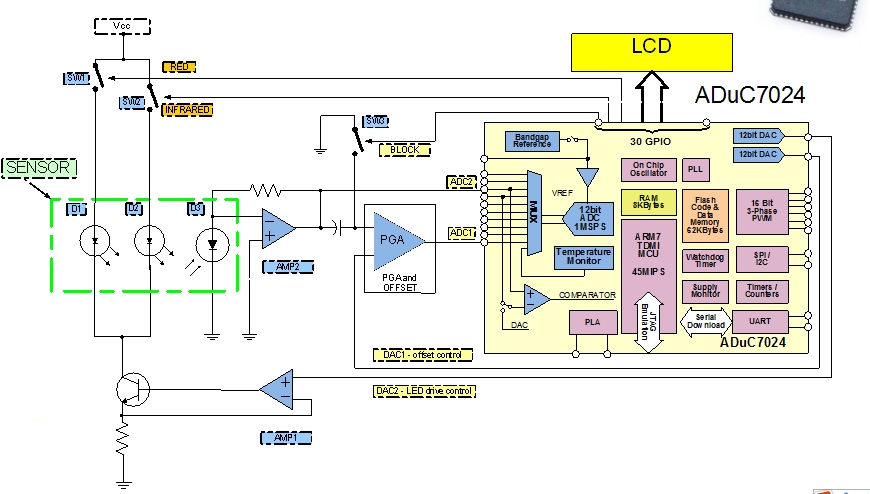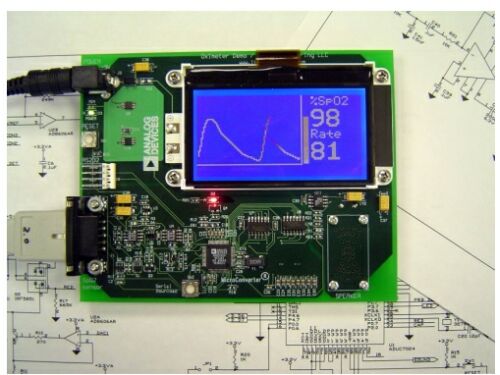Low cost, small size pulse oximeter solution
Low cost, small size pulse oximeter solution
Hemoglobin is an important part of blood cells. It is responsible for transporting oxygen from the lungs to other tissues in the body. The amount of oxygen contained in hemoglobin at any time is called blood oxygen saturation (ie SpO2).
Blood oxygen saturation is an important physiological parameter that reflects whether the human respiratory function and oxygen content are normal. It is an important physiological parameter that shows whether the various tissues of our body are healthy. Severe hypoxia can directly lead to tragedies such as suffocation, shock and death.
In the lungs, oxygen attaches to a protein bound by red blood cells called hemoglobin (symbol Hb). There are two forms of hemoglobin in the blood: oxyhemoglobin (HbO2) and reduced hemoglobin (Hb), then
Blood oxygen saturation SpO2 = (HbO2x100) / (HbO2 + Hb) x100%
The test principle of the oximeter is: oxyhemoglobin and reduced hemoglobin have different absorption characteristics in the visible and near infrared spectrum range. Reduced hemoglobin absorbs more red frequency light and absorbs less infrared frequency light; while oxygenation Hemoglobin absorbs less red frequency light and absorbs more infrared frequency light. This difference is the most basic basis of the SpO2 measurement system.
To measure the human body's absorption of red and infrared light. The red and infrared light-emitting diodes are located as close as possible to each other, and the emitted light can pass through single tissue points in the human body. A single photodiode that responds to red and infrared light receives light first, and then a transimpedance amplifier generates a voltage proportional to the received light intensity. Red and infrared LEDs are usually time multiplexed, so they don't interfere with each other. The ambient light is estimated to be deducted from each red and infrared light. Measurement points include fingers, toes and earlobe.
Pulse oximeters provide a noninvasive method to measure blood oxygen saturation or arterial hemoglobin saturation. The working principle of pulse oximeter is based on the change of light absorption during arterial pulse. Two light sources located in the visible red light spectrum (660 nanometers) and the infrared spectrum (940 nanometers) alternately illuminate the area under test (generally fingertips or earlobe). The amount of light absorbed during these pulsations is related to the amount of oxygen in the blood. The microprocessor calculates the ratio of the two spectra absorbed, and compares the result with the saturation value table stored in the memory to obtain the hemorrhagic oxygen saturation.
A typical oximeter sensor has a pair of LEDs that face a photodiode through the translucent part of the patient's body (usually the fingertip or earlobe). One of the LEDs is red and the wavelength is 660nm; the other is infrared and the wavelength is 940nm. The percentage of blood oxygen is calculated based on measuring the two wavelengths of light with different absorption rates passing through the body.

Fig. 1: Circuit block diagram of oximeter based on ADI's ADuC7024.
The figure above shows the block diagram of the oximeter circuit based on ADI's ADuC7024. ADuC7024 oximeter chip. The microcontroller core of this precision analog microcontroller is ARM7TDMI, with 8KB of SRAM and 62KB of non-volatile flash / EE memory integrated on-chip. The ADuC7024 integrates an MSPS, 12-bit, multi-channel high-performance ADC data acquisition system, 16-bit / 32-bit MCU, and Flash / EE memory in a single chip. The ADC has up to 12 single-ended input channels, and 4 ADC input channels can also be multiplexed with the output pins of 4 DACs. The ADC can work in single-ended mode or differential input mode, and its input voltage is 0 V to VREF. The low drift bandgap voltage reference, temperature sensor and voltage comparator complete the ADC peripheral settings.
This solution has low cost, small size, excellent low perfusion and spontaneous anti-jamming performance, and high flexibility. The cost of this oximeter chip and some analog devices is lower than the cost of a complete oximeter OEM module. The customization of the firmware can meet the user's application needs. By changing the firmware, it can handle any type of communication, display, and operation interface. It can also change the parameters of the oximeter algorithm to meet special application needs, such as sleep research, home telemetry, etc. This solution is a single chip and requires only a small amount of front-end adjustment circuits, so the entire device will be very small.
The figure below is the ADI SpO2 demonstration system.

Figure 2: ADI SpO2 demonstration system.
Glass tube fuses are made by glass shell, some metal wires and two brass caps. Fuse is small safety part in an electrical device or piece of machinery that causes it to stop working if the electric current is too high, and so prevents fires or other dangers. Fuse in the abnormal current increases to a certain height and heat, its own fuse to cut off the current, to protect the safe operation of the circuit fuse protection power equipment with current overheating damage, avoid electronic equipment serious damage caused by internal fault. When a circuit breaks down or is abnormal, the current increases with the current and the increased current may damage some important components in the circuit, and it may also burn the circuit and even cause a fire. If correctly placed in the circuit fuse, the fuse will be abnormal current increases to a certain height and heat, its own fuse to cut off the current, so as to protect the safe operation of the circuit.
Auto Glass Tube Fuses
Auto Glass Tube Fuses,Max Fuse,High Quality Blade Fuse,Fuse Block
Heshan Jianhao Lighting Industrial Co., Ltd. , https://www.sunclubtw.com